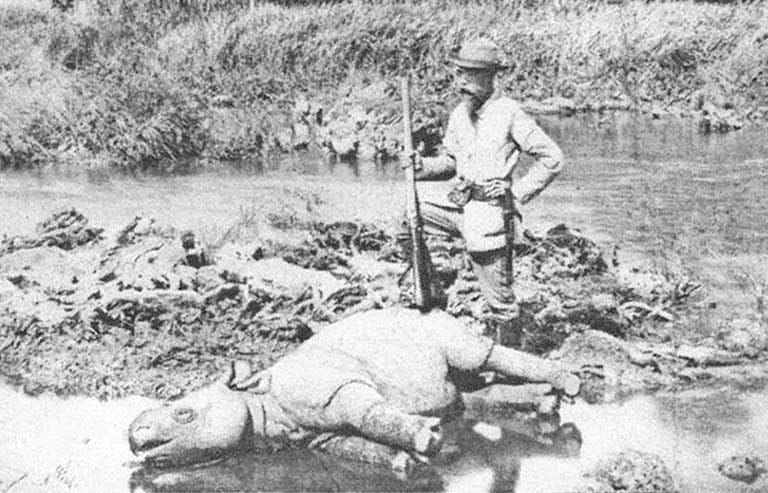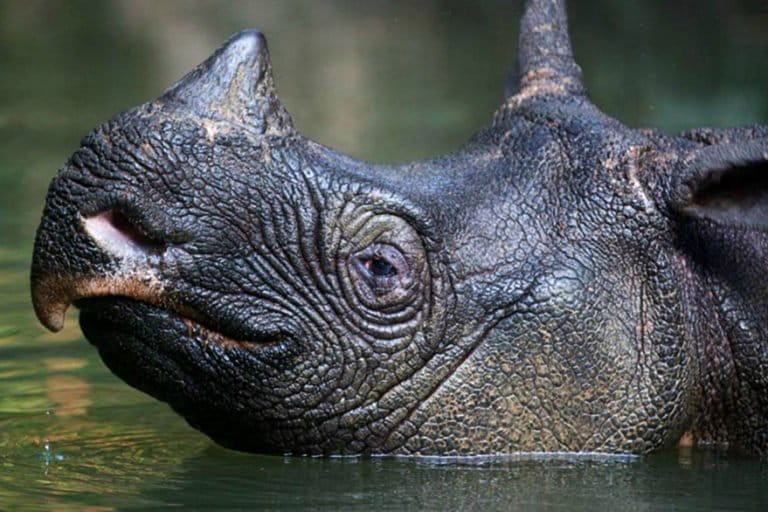- Indonesia’s Javan rhinos were widely hunted until they were protected by a Colonial-era law in 1910. Even then, enforcement was limited.
- Since 1921, the Ujung Kulon peninsula in western Java has been protected as a reserve for Javan rhinos. It is now the species’ sole remaining habitat.
- Ujung Kulon’s rhino population faces numerous challenges including invasive plants, competition from wild cattle and the risk of natural disasters and disease.
- This post is a commentary. The views expressed are those of the author, not necessarily Mongabay.
In the middle of the night toward the end of 1982, where the forest meets the beach, an old man, thin and barefoot, visited the Karangranjang Resort barracks in Ujung Kulon National Park. “Abah Murdja’i,” said Saridan, a forest ranger who served in the area.
Abah (“father” in the local Sundanese dialect) Murdja’i isn’t just anyone. He used to be the leader of a group of rhino hunters in Ujung Kulon. He served five years in jail, from 1974 to 1979, after being arrested at dawn on the Cikalejetan River. Just before his arrest, he’d pulled a gun on one of the officers chasing him, but the weapon exploded, severing the fingers on his right hand. He was taken into custody and tried in the Pandeglang District Court.
At the resort, Murdja’i recounted his adventures hunting rhinos over the course of 20 years, a period during which he was unstoppable.
“Why were you finally caught in Cikalejetan, Abah?,” Saridan asked. “It was just my time,” Murdja’i replied in Sundanese. Murdja’i’s gun, nicknamed “The Corpse,” featured 27 notches on the handle. Each one represented a rhino he had shot. “That means that every year, I killed a Javan rhino in Ujung Kulon,” he said.
For a quarter of a century, from 1950 to 1975, two hunters in Ujung Kulon, Murdja’i and Sarman, who was captured in 1979, claimed to have hunted more than 50 rhinos (Sadjudin, 1986; Sadjudin, 2015). The Javan rhino population in Ujung Kulon in 1937 was estimated at 25 individuals (10 male and 15 female); in 1955, there were 30 to 35 (Hoogerwerf, 1970).
The first census of Javan rhinos in Ujung Kulon was conducted in 1967, and the population was estimated at between 21 and 28 individuals. The fluctuation in the rhino population during that time was influenced by both births and hunting (Schenkel and Schenkel, 1969). After the institution of strict supervision, the number of rhinos grew to 45 individuals (Schenkel et al, 1978). If Murdja’i and Sarman hadn’t been caught by police, it’s possible there would be nothing left of the Javan rhino but a story.
The British researcher Blyth (1862) wrote about the trade in Javan rhino horns, as many as 2,500 of which were exported to China every year. That would have meant seven rhinos were killed each day.
Back then, the Javan rhino was spread across east and west Java and southern Sumatera (Blyth, 1862; Beaufort, 1934). It was considered a pest of teak, rubber and tea plantations by the Dutch colonial administration. This persisted until the end of the 19th century. Anyone who killed a rhino back then would be rewarded.

Asia and Africa are home to a combined five species of rhino. In Asia there are three species (Javan, Sumatran and Indian rhinos) and in Africa two species (the black rhino and the white, or square-lipped, rhino). The Javan rhino (Rhinoceros sondaicus) lives in Ujung Kulon, the most westerly point of Java.
Its previous range was quite extensive, covering east India, Bangladesh and Southeast Asia. In Southeast Asia, the Javan rhino could be found in Myanmar, Thailand, Laos, Cambodia, Vietnam, the Malay peninsula and Indonesia (Shebbeare, 1953; Ali and Santapau, 1958). It’s also possible the rhino could have ranged into southern China along the Mekong and Songkoi rivers (Blyth, 1862; Loch, 1937; Ansell, 1947; Talbot, 1960).
In Sumatra, the Javan rhino was found from Aceh in the north to Lampung in the south. In 1927, the rhino could still be found in Langkat, and in 1933 in Palembang (Beaufort, 1934; Groves, 1971). Buck and Evertt (1893) described fossils of Javan rhino teeth found in Sarawak, in Borneo. But besides this, there have been no other definite reports that the Javan rhino lived in Borneo (Beaufort, 1934; Loch, 1938; Groves. 1971).
These animals could still be found in the Central Java areas of Wonosobo as late as 1833, Nusakambangan (1834), Telaga Warna (1866), and Mount Slamet in 1867; and in the West Java areas of Tangkuban Perahu in 1870, Mount Gede and Mount Pangrango (1880), Mount Papandayan (1881), Mount Ceremai (1897), and Karawang (1912). Areas once inhabited by rhinos still bear the legacy with names such as Ranca Badak in Bandung, Rawa Badak in North Jakarta, Kandang Badak in Mount Gede Pangrango National Park, and Cibadak in Sukabumi. (Badak is the Indonesian word for rhino.)
Previously, Javan rhinos were also found in Siwalik Hill, India (the specimens are now in the Indian Museum in Kolkata) and in Cat Tien National Park, Vietnam, where the last Javan rhino was shot by hunters in 2010. The last rhino in Java outside of Ujung Kulon was killed in 1934 by a Dutch zoologist in Cipatujah, Tasikmalaya; the specimen is now stored in the Bogor Zoological Museum (Sadjudin, 2015).
In 1910, the Javan rhino was officially protected by the Dutch East Indies government, although the threat of poaching persisted, as there was no effective enforcement of the law. In 1921, based on the recommendation of the Netherlands Indies Society for Protection of Nature, Ujung Kulon was declared a nature preserve by the Dutch government (Hoogerwerf, 1970). Currently, the Javan rhino is designated as critically endangered, or one step from extinction, by the International Union for Conservation of Nature (IUCN).
Today, the Javan rhino’s extremely limited population can only be found in the narrow natural habitat of the Ujung Kulon Peninsula. Animals like the Javan rhino whose range has been reduced to a small area are known as relicts and are more vulnerable to extinction compared with endemic animals that have always had a limited range.

Early in 1982, five Javan rhino carcasses were found around Cibandawoh, Karangranjang and Kalejetan. These animals died along the beach and on the banks of rivers. The suspected cause of death was “snoring disease,” or hemorrhagic septicemia, contracted from water buffalo released into the forest surrounding Ujung Kulon National Park by residents. Most recently, a rhino named Samson was found dead on the edge of Karang Panjang Beach due to colic or intestinal torsion, a twisting of the large or small intestine. This condition is a part of life for rhinos in Ujung Kulon.
Another factor adding to the Javan rhinos’ vulnerability is the relatively small population. Based on camera traps, it is estimated there are 68 individuals. Small populations in limited habitats lead to low heterogeneity; inbreeding passes down genetic weaknesses to each newborn individual. Each subsequent generation will be vulnerable to bouts of disease, such that the Javan rhino will become increasingly endangered.
However, according to Tony Suhartono, the former director of wildlife conservation at the Ministry of Environment and Forestry, in private correspondence in 2015, the rhino, like some other species of wildlife, has a wide barcode. In other words, it can maintain its population in the long run even with a small population, unbalanced sex ratios, and inbreeding. What is most important is that the population is strictly managed to the greatest extent possible.

Another factor that threatens the survival of rhinos is a plant known locally as langkap. Arenga obtusifolia, or the arenga palm, grows very rapidly, preventing sunlight from penetrating to the forest floor, affecting the growth of the rhino’s favorite food sources. In several locations in Ujung Kulon, the proliferation of other tall plants such as rattan (Calamus spp.), salak (Salacca edulis) and cangkeuteuk bamboo (Schizostachyum zollinaeir) also makes it difficult for the rhinos’ preferred food plants to develop. The area suitable for Javan rhino habitat is estimated to be only 40 percent of the entire Ujung Kulon peninsula, which covers around 100 square kilometers (39 square miles).
A frightening, extinction-level threat to the Javan rhino that cannot be ruled out is a natural disaster, such as the eruption of Mount Anak Krakatau. In 1883, the more famous volcano from which it derived erupted, spawning tsunami waves as high as 40 meters that killed more than 40,000 people in the provinces of Banten, on Java, and Lampung, on Sumatra. At the time, Javan rhinos, with a limited population, probably saved themselves by heading uphill on Mount Payung (elevation 420 meters, or 1,380 feet) and Mount Honje (620 meters, or 2,030 feet).
The eruption of Mount Anak Krakatau on Saturday, Dec. 22, 2018, caused a tsunami that struck the coasts around the Sunda Strait. Sumur subdistrict in Pandeglang district, where the entrance to Ujung Kulon National Park is located, was severely impacted by this disaster. So far, the Javan rhinos are reported to be fine.
Given all these problems, and the additional threat of competition for space and feed from the wild cattle known as banteng (Bos javanicus) that live in the same pocket of habitat in Ujung Kulon, a second habitat is desperately needed as a solution to prevent the extinction of the Javan rhino.
Haerudin R. Sadjudin is a senior rhino researcher who has been involved in rhino conservation program for over 40 years in Indonesia.
This commentary was first published on our Indonesian sister site on Dec. 27, 2018.
CITATIONS:
- Ali And Santapau (1958). Rediscovery of smaller asiatis on horned rhinoceros (Rh. sondaicus) in Malaya. J. Bombay Nat. Hist. Soc. 55.
- Beaufort, L.F.(1934). On the occurence of Rhinoceros sondaicus in Sumatra. Tijdscr Ned. Dierk. Ver. Ser. 1.
- Blyth, E (1862). A memoir on living Asiatic species of Rhinoce- ros. J. Asiatic Soc. 31.
- Groves, C.P. (1967). On the rhinoceros of Southeast asia. Sauge tierk. Mittle. MUnchen, 15.
- — (1971). Species characters in Rhinoceros horns. Sagutierk. Mittle. Munchen, 36.
- Hoogerwerf. A. (1970). Udjung Kulon The Land Of The Last Javan Rhinoceros. Leiden: E.J. Brill.
- Loch, C.W. (1937). Rhinoceros sondaicus the javan rhinoceros and its geographical distribution. J. Malayan Branch, Royal Asiatic Soc. 15, part II: 130, 1937.
- Sajudin, H.R. : Badak Jawa (Rhinoceros sondaicus DESMAREST, 1822) di semenanjung Ujung Kulon. Biologi Univ. Nasional, Jakarta, 1983.
- Sajudin, H.R., Djaja, B. and Lo, Y.K. (1981) Sensus badak Jawa (Rhinoceros sondaicus DESMAREST, 1822) di semenanjung Ujung Kulon-Maret 1981. IUCN/WWF Project No. 1960-Indonesia, Ujung Kulon Javan Rhinoceros. Fak. Biologi Univ. Nasional, Jakarta, 1981 (laporan khusus no. 3).
- Schenkel, R. And Schenkel, L.H. (1969) The javan rhinoceros (Rh. sondaicus Desm.) in Udjung Kulon Nature Reserve. Its ecology and behaviour, Field Study 1967-1968. Acta Trop. 26: 97.
- Schenkel, R., Shenkel, L.H. And Ramono, W.S. (1978). Area Management for the javan rhinoceros (Rhinoceros sondaicus Desm.) a pilot study, The Malayan Nat. J. 31: 253-275.
- Shebbeare, E.O. (1953). Status of the three asiatic rhinoceros. Oryx. 2: 141.













